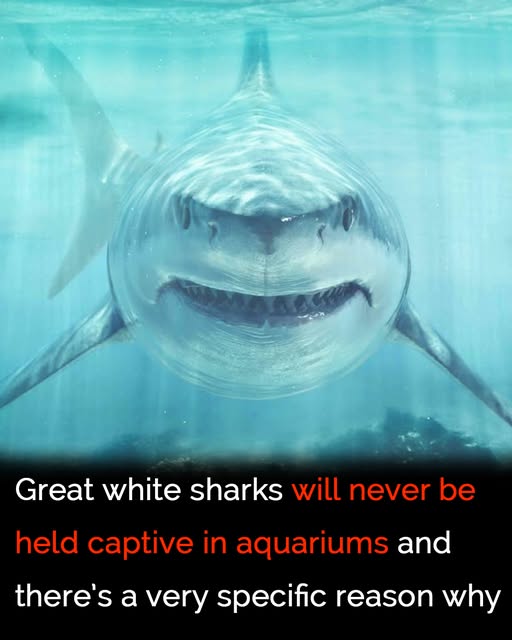The first time I stepped foot into the Miami Seaquarium, I felt like I was entering an entirely new world. The vibrant colors of tropical fish, the synchronized flips of dolphins, and the powerful presence of orcas created an unforgettable experience. It was pure magic. As a child, I was completely enchanted by the beauty and majesty of marine life, and those early memories would go on to influence how I viewed the ocean and the animals who call it home.

But as I grew older and gained more understanding of the world, I began to reflect more deeply on what I had witnessed. While aquariums offer a window into the underwater world, they also raise difficult questions—especially when it comes to housing large and highly intelligent marine animals. The more I learned, the more I started to grapple with the ethics of keeping powerful predators in confinement for human entertainment or education. And one question that continued to surface in my mind was this: Why don’t we ever see great white sharks in aquariums?
For years, I had marveled at the grace of stingrays, the playful antics of sea lions, and the awe-inspiring presence of massive sharks. But never once did I see a great white shark behind glass. It’s not just that they’re rare—it turns out there’s a deeply heartbreaking reason why you won’t find these apex predators in captivity.
Despite decades of attempts by marine parks and scientists, no one has been able to successfully keep a great white shark in an aquarium for long. These majestic creatures, often misunderstood due to movies and media, are not just large—they have unique physiological and psychological needs that make captivity an impossible challenge. Their bodies and instincts are finely tuned for life in the vast open ocean, and no man-made enclosure can replicate that.
In fact, the very first recorded attempt to house a great white shark occurred in 1955 at Marineland of the Pacific, near Los Angeles. The outcome was tragic: the shark died within a single day. That same year, the park also kept blue sharks in captivity, but even they refused to eat. Staff were forced to intervene in unsettling ways, using divers to pry open the sharks’ mouths and push food inside just to keep them alive. It was an early warning that some ocean creatures simply do not belong in tanks.
Undeterred, Marineland tried again in 1981. This time, they captured a juvenile female great white, only about one year old. The idea was that her young age and smaller size—she was just under five feet long and weighed about 50 pounds—might make it easier for her to adapt. At first, things seemed to go well. Scientists monitored her every move around the clock, hopeful that this time would be different. But after just seven days, she too died. The hope of a breakthrough turned into yet another somber failure.
Over the years, other aquariums attempted to do what Marineland could not. Most notable was the Monterey Bay Aquarium, which managed to keep a great white alive longer than anyone else—sixteen days. Even then, the shark had to be released, and it died soon afterward. Every effort since then has ended either with the shark being let go early or dying not long after being captured. No one has cracked the code of how to keep these animals alive in a tank.
So what makes great white sharks so uniquely unsuited for captivity? First, there’s their complex diet. Great whites are carnivores that hunt for large, live prey—ranging from tuna and other fish to sea lions and even dolphins. Feeding them in captivity would not only be logistically difficult and expensive but also emotionally disturbing for guests.
Then there’s the way great whites breathe. Unlike many other fish that can pump water through their gills while remaining still, great white sharks need to swim constantly to breathe. The act of swimming pushes oxygen-rich water into their mouths and over their gills. If they stop moving, they literally suffocate. This means they need tanks so enormous—both in width and length—that no existing aquarium can provide the space they require to swim naturally.
And then comes the psychological toll. Numerous reports from marine experts and staff members have noted that great whites become visibly distressed in captivity. They often stop eating altogether, eventually starving themselves. Others become aggressive, slamming their heads into the walls of their enclosures, likely out of sheer confusion and frustration. According to marine conservation groups like Shark Bookings, “Great white sharks kept within tanks have been known to head butt their noses into the glass walls and lose their appetites… they get increasingly aggressive in their depressed state.” These behaviors are heartbreaking indicators of how deeply captivity harms them.
So, while the image of a great white shark gliding behind glass might seem awe-inspiring to some, the truth behind such a display would be one of suffering and loss. These animals are not built for confinement. Their biology, their instincts, and their sheer size make them incompatible with life inside an aquarium.
There’s a reason that “Jaws” and its real-life counterparts capture our imagination—they are magnificent, mysterious, and powerful symbols of the wild. But with that power comes a responsibility to protect them, not to imprison them. The ocean is their natural domain. It’s where they hunt, travel, mate, and live out their lives as nature intended. Trying to recreate that environment behind glass simply doesn’t work—and it never will.
So the next time you walk through an aquarium, mesmerized by the creatures swimming behind the glass, take a moment to remember the ones who aren’t there. The ones like the great white shark, whose needs are too great and whose spirits are too wild to ever be truly captured. In a world where so much of nature is being pushed to the brink, maybe the greatest act of respect we can show is to let them be free. That’s where they thrive. That’s where they belong.





